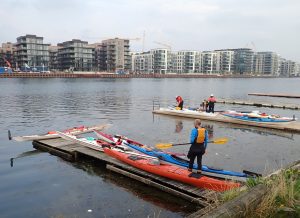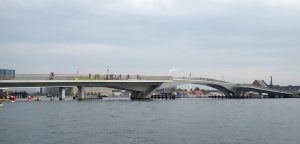There is no coastline in Denmark that changes more quickly than Copenhagen’s harbour, so here is an architectural update. Our tour begins from one of the very few green banks left in the harbour, at Bryggen kayak klub.
This is towards the south of the long harbour channel and in the midst of a building boom in close packed apartments for rich people.
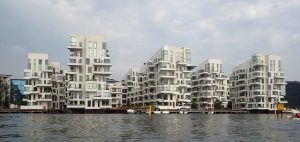
As we paddled north the last remnants of human quirkiness gave way to the dreary pomposity of international company offices.
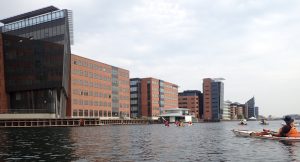
The harbour sold its waterfront to developers, so it has to lease back the moorings. The only good aspect of this sad evolution is that there is pedestrian and cycle access all around the harbour. Kayak access is not so easy. There are vertical ladders at intervals along the steel piling edge. When there is much water traffic the waves rebound from this hard edge and pile up against the next incoming wave. The wind concentrates through the gaps between the massive buildings. Then there are the hire boats…
The car-free cycle paths are linked across the channel by bridges. This is the “Kissing Bridge”, named because the span opens in the middle by sliding back to allow tall ships through. The popular title is not entirely deserved because its first kiss was romantically delayed by years of engineering and financial troubles. When it was finally brought into use the centre spans failed to kiss, attributed by the engineers to cold water distorting the support structure.
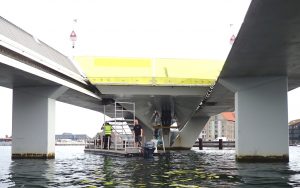
It still requires loving care today.
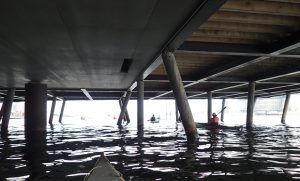
Just north of the hesitant kiss is the slalom course under the national theatre.

The harbour’s golden commercial period is represented by the West Indian store house, originally full of sugar and rum from the Danish West Indian possessions, which provided the wealth for the grand merchants’ dwellings and warehouses. It now contains a large collection of plaster casts, advertised by a copy of Michelangelo’s David poised wondering if the water is too cold to jump into.
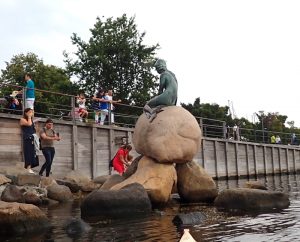
A bit further north we passed another famous statue.
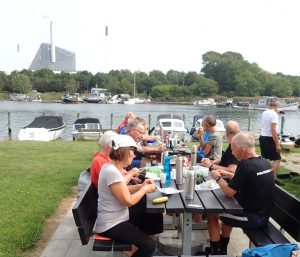
It took some time and nearly a kilometre of paddling to find a spot for lunch, our usual landing places having been covered with paving or houses. There is a tiny patch of green, with a jetty, at the tip of Holmen. This was once Denmark’s naval base but is now home to the aesthetic professions: the schools for art, architecture, music and film. At the top left of the picture is the vast bulk of Amagerbakke. This is a combined electricity and district heating powerhouse, run on waste and wood chips. It has a ski slope on its roof and a climbing wall.
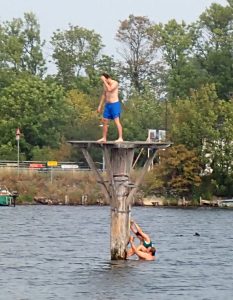
We were lunching by one of the rings of water that encircled and defended the main harbour. All the water in and around the harbour is clean enough to swim in, and in late August also warm enough.
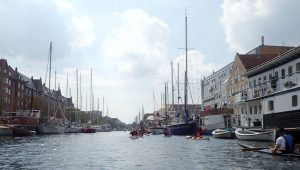
We turned south down Christanshavn canal, lined with posh yachts which from a kayaker’s viewpoint, completely obscured the view of the fine merchants’ houses from the 17th century. One also has to watch out for the picnic boats, which are clumsy and often badly steered open boats with a table and benches for eight people, and space for many crates of beer. It is not so easy to turn around to look astern.
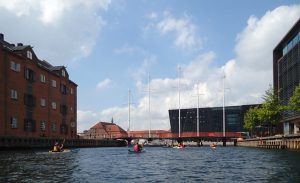
As one emerges from Christianshavn into the main harbour channel one can see many architectural styles. On the left a warehouse from the 18th or 19th c. In the distance on the left is the weapons store of King Christian 4 from 1604; in the center are the poles supporting Olafur Eliasson’s bridge of circles, from 2015. Beyond is the Black Diamond, the Royal Library by Schmidt Hammer Lassen from 1999. This is the first and best of the depressing series of copycat outward sloping glass walls which line the southern half of the harbour. On the right is a glimpse of the sombre repetitive office blocks by Henning Larsen from the 1990s. The harbour had the misfortune to be redeveloped in a dreary time for corporate architecture and speculative apartment building but now it is adding more playful and human scale structures.
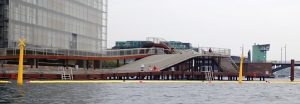
This muddled combination of skateboard ramp, swimming pool and kayak polo space is shadowed in the late afternoon by the bulk of Nykredit bank building. But then one can walk over Langebroen, with its copper clad control tower (right side in the distance) to the swimming pool, bar and boat hire on the sunny side.
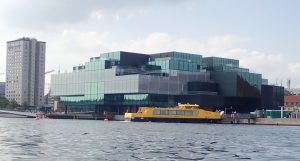
There are more substantial examples of reaction against the soulless rank of offices that line so much of the waterfront. This is BLOX, completed in 2018, which combines exhibition space, entrepreneur space, apartments, cafe, playground and parking. The regular harbour bus service is poking its nose into the gangplank.
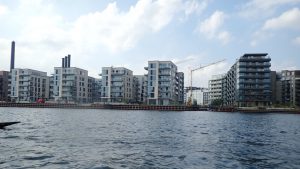
We paddled back to our small grassy landing place, past apartment blocks that could be anywhere in the world, and preferably somewhere else. Looming behind the concrete ramparts are the last remnant of the busy industrial region that Copenhagen harbour once was. The chimneys belong to the Man Diesel factory, now delicately renamed Man Energy Solutions.
This was my third tour of Copenhagen harbour over the years. I have seen it change from a decaying industrial south harbour and an old fashioned patrician middle harbour to a dreary, and very windy, row of office blocks. Now it is returning to civilisation, providing many ways to enjoy our prosperity and freedom on a human scale.
tim
